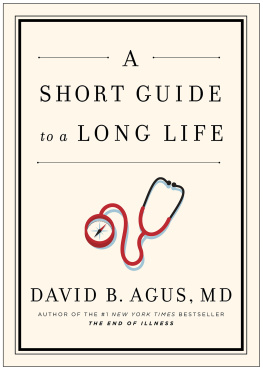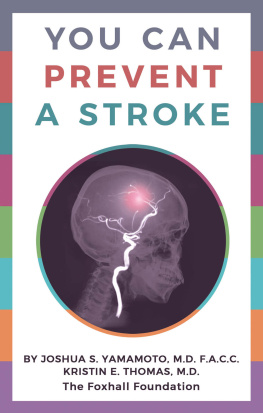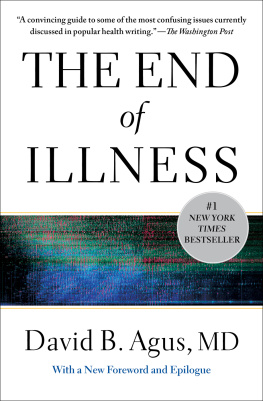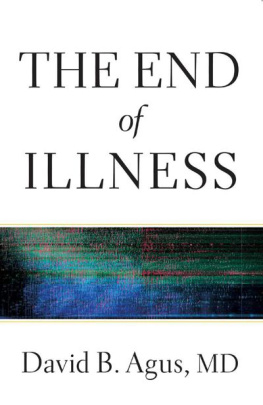More praise for The Lucky Years
Dr. Agus describes how a series of scientific breakthroughs enables everyone to lengthen and improve their livesa future in which our bodys natural mechanisms can be enlisted to fight disease and our genes can be edited to eliminate inherited ones. It is an inspiring vision.
Larry Ellison, cofounder and executive chairman, Oracle Corporation
The Lucky Years is a steady dose of actionable knowledge about the one thing relatable to everyone: life. Its the doctor-patient relationship we all want and deserve. Dr. Agus is a trusted voice in a field of uncertainty.
Ashton Kutcher
It sometimes takes a genius to know the difference between whats good and bad for us amid all the noise in health circles. Thanks, David Agus, for being that genius.
Michael Dell, founder, chairman, and chief executive officer, Dell, Inc.
The Lucky Years inspires you to live a more healthful and meaningful life and provides practical and hopeful guidance for the path ahead. Dr. Agus will show you what it truly means to enjoy the lucky years.
Dov Seidman, author of How: Why How We Do Anything Means Everything
Dr. Agus presents a provocative, highly informative way of understanding revolutions in health and health care today that will change the quality of our lives.
Murray Gell-Mann, PhD, Nobel Laureate in Physics, 1969, and distinguished fellow and cofounder of the Santa Fe Institute
Dr. Agus once again gives us a clear path to better health. We are lucky to have such an incredible guide to such a critical subject.
Marc Benioff, chairman and CEO, salesforce.com
Thank you for downloading this Simon & Schuster eBook.
Join our mailing list and get updates on new releases, deals, bonus content and other great books from Simon & Schuster.
C LICK H ERE T O S IGN U P
or visit us online to sign up at
eBookNews.SimonandSchuster.com
Contents
NOTE TO READERS
This publication contains the opinions and ideas of its author. It is intended to provide helpful and informative materials on the subjects addressed in the publication. It is sold with the understanding that the author and publisher are not engaged in rendering medical, health, or any other kind of professional services in the book. The reader should consult his or her medical, health, or other competent professional before adopting any of the suggestions in this book or drawing inferences from it. The author and publisher specifically disclaim all responsibility for any liability, loss or risk, personal or otherwise, which is incurred as a consequence, directly or indirectly, of the use and application of any of the contents of this book.
To my dear children, Sydney and Miles:
On May 25, 1961, President John Fitzgerald Kennedy proclaimed, I believe that this nation should commit itself to achieving the goal, before this decade is out, of landing a man on the moon and returning him safely to the earth.
On July 20, 1969, Neil Armstrong with the Apollo 11 crew fought to land the lunar module before it ran out of fuel. Armstrong eventually took that first step on the moon. The average age of the remarkable team at Mission Control in Houston was twenty-six years old.
That means the scientists and engineers in Mission Control were just eighteen years old when Kennedy made his 1961 statement. These teenagers who listened to President Kennedy were the future space program. Similarly, you and your generation are our future in health and medicine. We need you and are depending on you so we can continue the Lucky Years.
And to my partner, best friend, and wife, Amy:
Your love and support inspire me daily. I am so excited and privileged to continue to enjoy the Lucky Years with you...
... most men and women will grow up to love their servitude and will never dream of revolution.
Aldous Huxley, Brave New World (1932)
List of Illustrations
: Parabiotic mice. Courtesy of author.
: Inflection point curve. Courtesy of author.
: Photo of Dr. William Coley. Public domain.
: Brain scans of tumor shrinking using polio virus. Images courtesy of the Preston Robert Tisch Brain Tumor Center at Duke University. Used with permission.
.
: Caricature of Metchnikoff. Reprinted with permission of the Institut PasteurMuse Pasteur.
: End of History illustration. Courtesy of author.
.
.
: Quantification of biological aging graphic. Duke University School and Medicine and the National Academy of Sciences. Used with permission.
: Tumor sequencing results (lung cancer). Courtesy of Foundation Medicine, Inc.
.
.
: Tumor sequencing results (bladder cancer). Courtesy of Foundation Medicine, Inc.
, accessed August 7, 2015.
: Photo of Sir William Osler. Medical archives of the Johns Hopkins Hospital. Used with permission.
: Caricature of Sir William Osler. Medical archives of the Johns Hopkins Hospital. Used with permission.
: My Osler residency team. Medical archives of the Johns Hopkins Hospital. Used with permission.
100: Examples of the Bills of Mortality. Courtesy of Jay Walker, the Walker Library of the History of Human Imagination. Used with permission.
.
: The illustration of new reproductive techniques is an adaptation of a similar illustration featured in the article. Courtesy of author.
: Chart of life expectancy. Figures based on data from the Organization for Economic Co-operation and Development. Adapted from the Wall Street Journal , March 17, 2015. Courtesy of author.
132: Charts and Figures from the Task Force Report on Noncommunicable Diseases, copyright 2015 by the Council on Foreign Relations. Reprinted with permission. The data source is Institute for Health Metrics and Evaluation, Global Burden of Disease Study 2013.
.
: Physical activity and life expectancy. Data from S. C. Moore et al., Leisure Time Physical Activity of Moderate to Vigorous Intensity and Mortality: A Large Pooled Cohort Analysis, PLOS Medicine 9, no. 11 (2012): E1001335. Graphic courtesy of author and based on similar graphic in paper. National Cancer Institute and the Public Library of Sciences. Used with permission.
: Courtesy of Duke Medicine. Originally published in M. W. Dewhirst, et al., Modulation of Murine Breast Tumor Vascularity, Hypoxia and Chemotherapeutic Response by Exercise, JNCI Journal of the National Cancer Institute 107, no. 5 (2015): djv040 DOI: 10.1093/jnci/djv040.
.
.
INTRODUCTION
Destiny of the Species
Welcome to the Lucky Years
O wonder!
How many goodly creatures are there here!
How beauteous mankind is! O brave new world,
That has such people in t.
William Shakespeare, The Tempest , act V, scene I
M iss Wanda Ruth Lunsford, twenty-six, must have been thinking about her own mortality the day she reported on a stunning experiment. Picture two rats, one old and gray, the other young and vivacious. Now imagine joining them surgically at their sides by peeling away a thin layer of skin and neatly stitching the exposed surfaces together. Through this Siamese-twin-like junction, the rodents are able to share their circulation, pumping each others blood and exchanging bodily fluids. Miss Lunsford and her colleagues wanted to see what would happen. Among the rats that survived the unnatural union, the geriatric ones physically turned into their younger counterparts, as if theyd tapped the fountain of youth. The elder rats gained shinier, more colorful fur and clearer eyes, taking on the general appearance of the younger rats hitched to their sides. A four-hundred-day-old rat, more or less akin to a middle-aged man, lived nearly as long as the spry counterpart to which he was attached.











